How to Make AI Generated Music Like a Pro
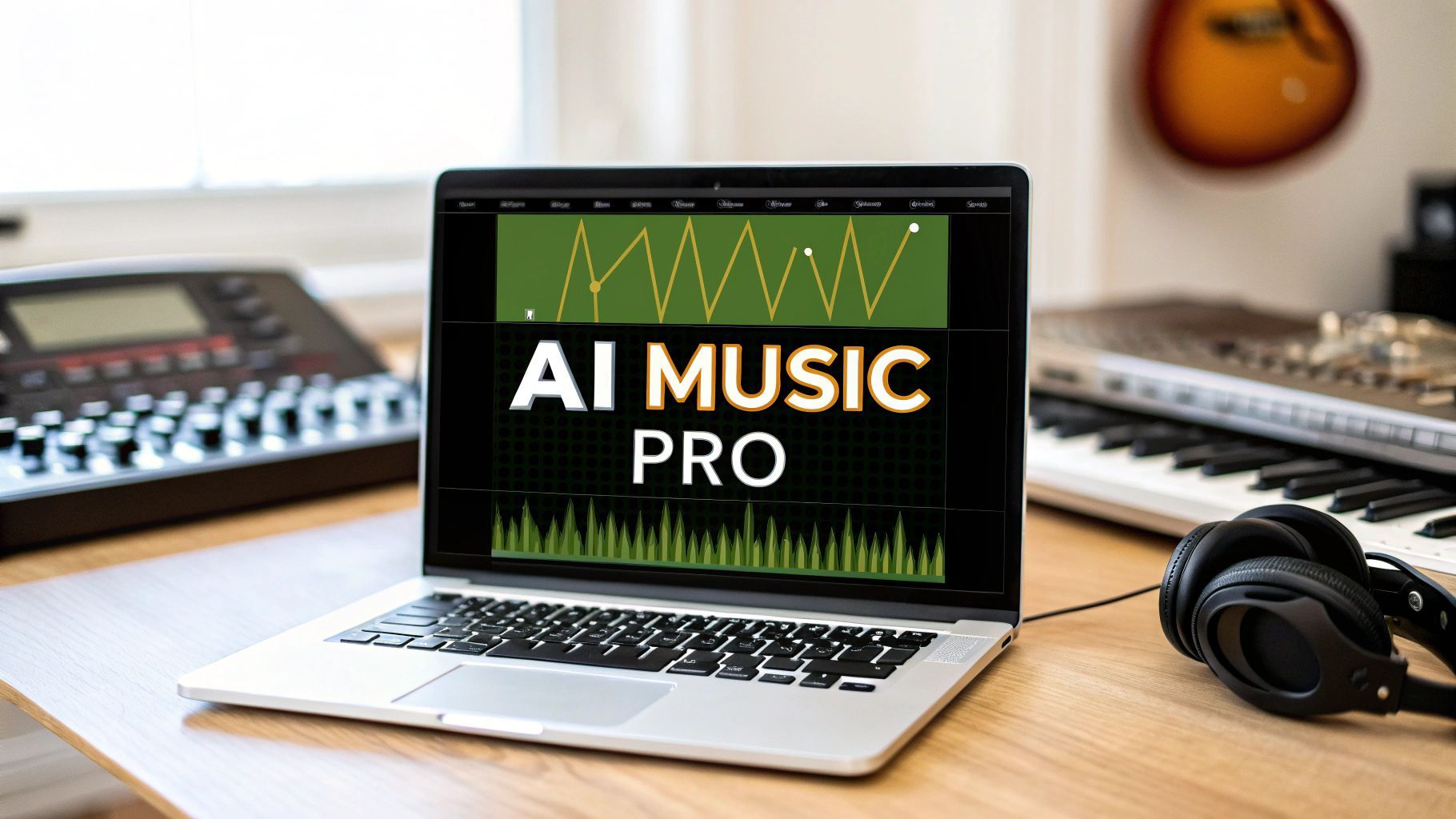


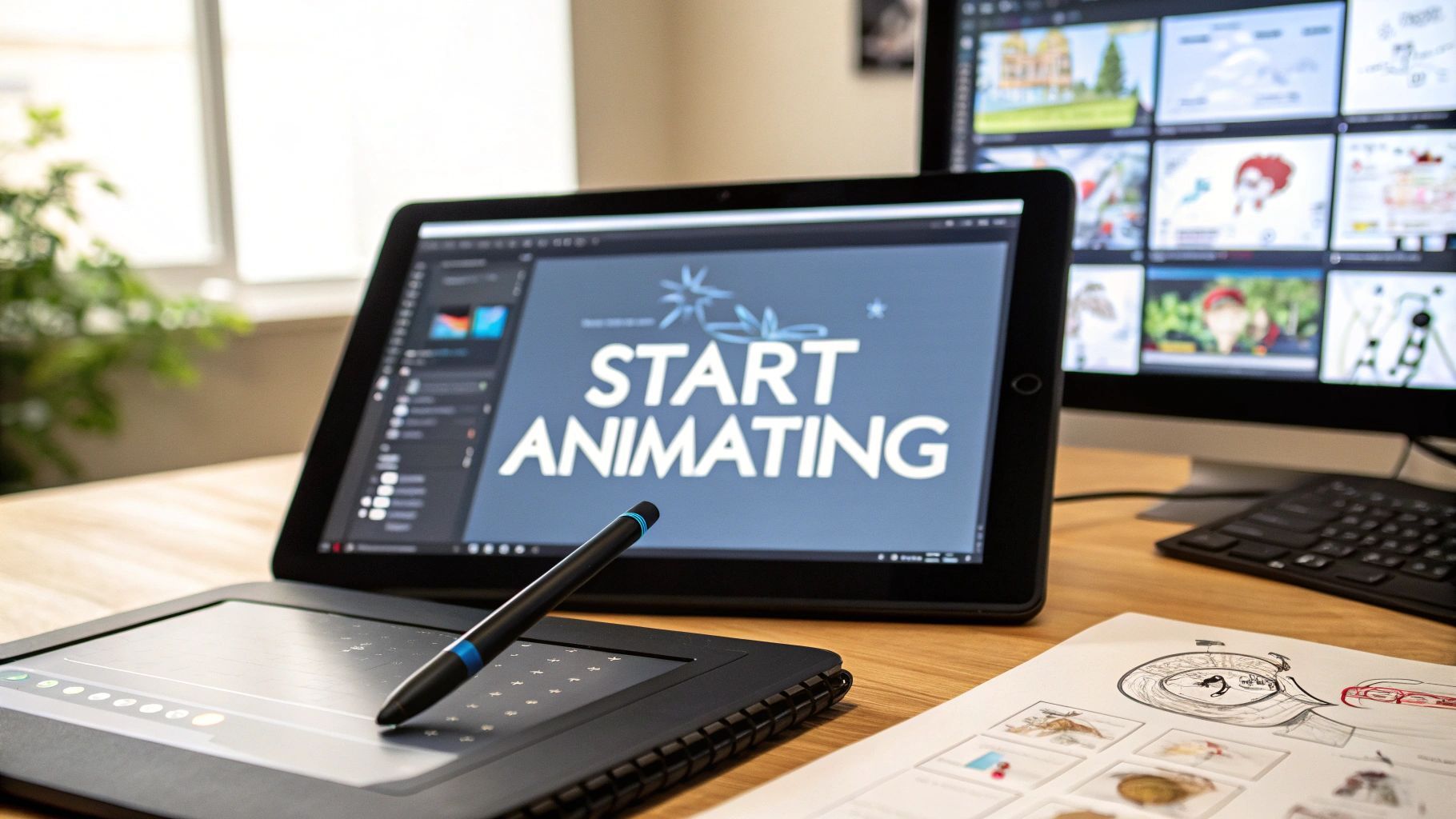
Discover the 7 best animation software for beginners in our ultimate 2025 guide. Compare features, pricing, and find the perfect tool to start animating today!
Ever watched a cartoon and thought, "I could do that"? Well, you're in the right place. Diving into the world of animation feels like unlocking a superpower, giving you the ability to turn static drawings into living, breathing stories. But with a universe of tools out there, picking your first one can feel like a huge boss battle. Don't sweat it. We've done the recon for you.
This guide is your ultimate cheat sheet to the best animation software for beginners. Forget endless searching and confusing tech jargon. We’re getting straight to the good stuff, breaking down exactly what each program offers, who it’s for, and how you can get started today. Whether you're aiming to create viral social media clips, professional-looking marketing videos, or your very own animated series, your perfect launchpad is on this list.
Each entry is packed with actionable insights, key features, and direct links to get you going instantly. We're cutting through the noise to help you find the right software to match your creative ambition and budget. Ready to bring your characters to life? Let's get those ideas moving
If the name Adobe makes you think of polished, professional tools, you’re on the right track. Adobe Animate is the creative giant’s answer to 2D animation, and it’s one of the best animation software for beginners who want to learn on a platform that will grow with them. It’s the direct descendant of the legendary Adobe Flash, rebuilt for the modern web to create everything from interactive web banners and educational content to full-blown cartoon episodes.
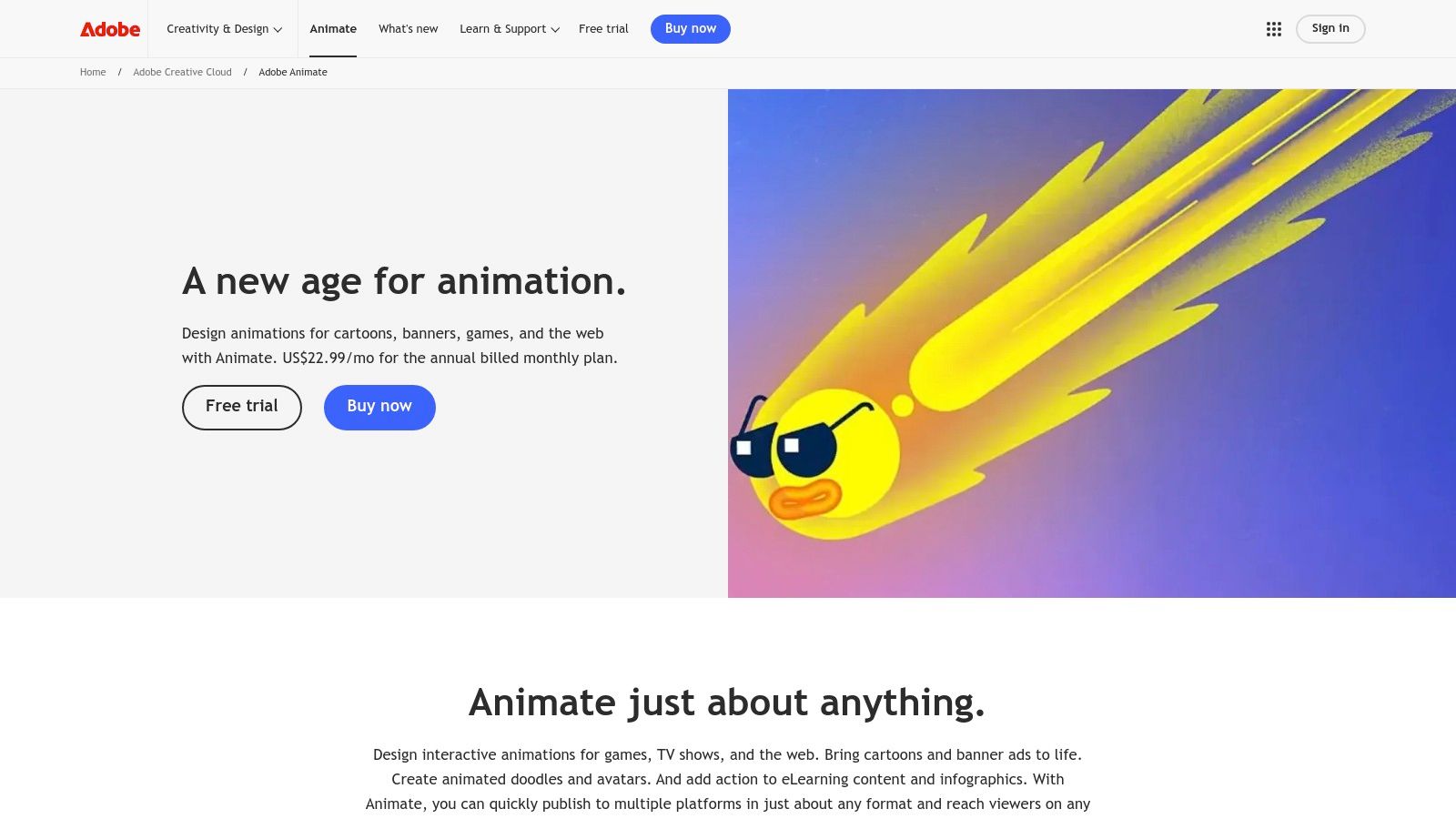
What makes Animate so welcoming for newcomers is its familiar Adobe interface and the massive library of tutorials and courses available. If you’ve ever touched Photoshop or Illustrator, you’ll feel right at home. It masterfully blends traditional animation principles like onion skinning with modern digital tools like the Asset Warp tool, which lets you rig and distort characters without redrawing every frame.
Adobe Animate isn’t just about drawing; it’s about bringing things to life with precision and exporting them virtually anywhere.
Versatile Timeline: The timeline is powerful yet intuitive, allowing you to control keyframes, layers, and motion with ease. Multi-Format Publishing: Export your work directly to HTML5 Canvas for websites, WebGL for interactive graphics, high-quality video for social media, or even animated GIFs for those perfect meme reactions. Creative Cloud Integration: Seamlessly pull assets from your Adobe Creative Cloud Libraries. Start a character design in Illustrator, import it into Animate, and add sound from Adobe Audition without a hitch. This integration streamlines the creative process significantly.
As part of the Creative Cloud ecosystem, Animate operates on a subscription model. You can get it as a standalone app or as part of the full Creative Cloud suite. Adobe offers a 7-day free trial, giving you plenty of time to explore its capabilities before committing.
Our Take: For aspiring animators who see this as a potential career path, learning Adobe Animate is a smart move. It’s frequently listed in job descriptions for web designers and animators, making it a valuable skill to add to your resume. While the subscription is a commitment, the professional-grade tools and industry recognition make it a worthy investment. Explore how Adobe is also incorporating new technologies into its creative suite by checking out some of the best AI video editing software.
If you've ever watched a modern animated show on TV and wondered what the pros use, chances are you're looking at Toon Boom Harmony. This powerhouse software is the industry standard for 2D animation, used by major studios from Disney to Nickelodeon. While that might sound intimidating, Harmony offers a scalable path that makes it one of the best animation software for beginners serious about learning the craft from the ground up.
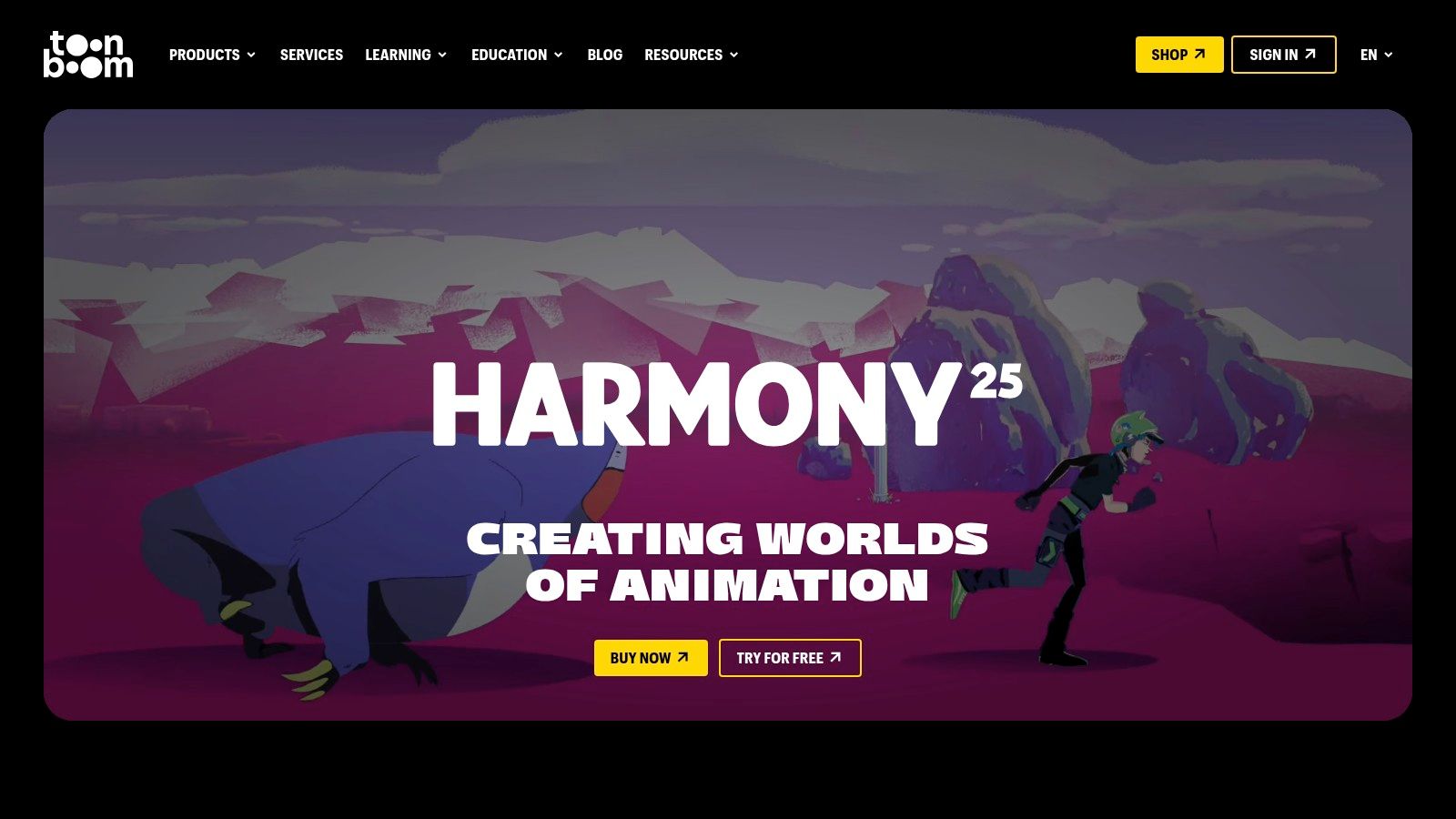
What sets Harmony apart for newcomers is its tiered system. You can start with Harmony Essentials, a version designed to introduce you to the core concepts of both traditional (frame-by-frame) and modern cut-out (rigged) animation. As your skills grow, you can move up to the Advanced and Premium tiers, which unlock the same sophisticated tools used to create shows like Rick and Morty and The Simpsons. This scalability means you won't have to learn a new program once you outgrow the basics.
Toon Boom Harmony is built around a professional production pipeline, giving beginners a taste of how real studios operate.
Powerful Drawing and Painting Tools: Harmony boasts advanced vector and bitmap drawing tools, including support for importing Photoshop brushes, giving you complete artistic freedom. Advanced Rigging and Cut-Out Animation: Even the Essentials version introduces powerful rigging capabilities. You can create puppets with bones and deformers, a key skill for efficient animation production that saves you from redrawing characters in every frame. Paperless and Traditional Workflow: Whether you want to draw directly in the software or scan hand-drawn sketches, Harmony supports both workflows seamlessly with excellent onion-skinning and frame management.
Toon Boom Harmony is professional-grade software with a price to match, but it provides accessible entry points. It operates on a subscription model with different pricing for its three tiers: Essentials, Advanced, and Premium. They offer a generous 21-day free trial, which is more than enough time to dive into its features. The company also has strong educational programs and discounts for students.
Our Take: Toon Boom Harmony is the go-to choice for beginners who dream of a career in the animation industry. The learning curve is steeper than simpler apps, but the skills you gain are directly transferable to a professional environment. Starting with Harmony Essentials is like learning to drive in a car that can eventually take you to a racetrack; you're building a foundation on a platform with limitless potential.
If recurring subscriptions feel like a creative drain, Moho offers a refreshing alternative. Developed by Lost Marble, Moho is powerful 2D rigging and animation software that you can own outright with a one-time purchase. It’s one of the best animation software for beginners who prefer a tool focused on creating puppet-like characters that can be animated efficiently, a technique widely used in web series and TV shows.
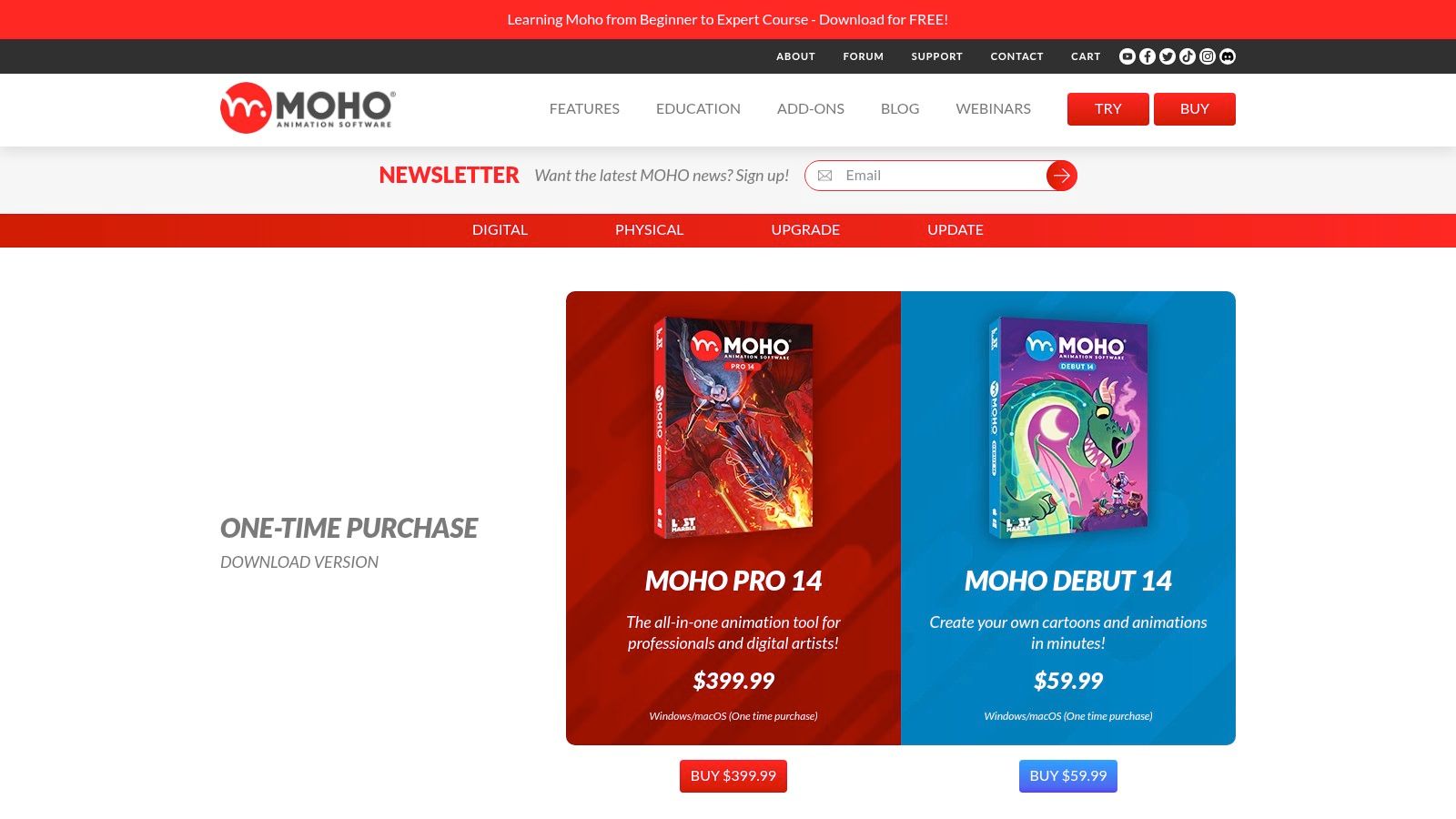
Moho splits its offering into two versions: Debut for beginners and Pro for seasoned animators. The Debut version is incredibly accessible and provides a fantastic entry point into the world of vector-based animation and character rigging. Its standout feature is its bone system, which allows you to create a skeleton for your characters and move them around like digital marionettes, saving you from the tedious process of redrawing every single frame.
Moho is designed around a rigging-first workflow, making it unique and powerful for character animation.
Powerful Bone Rigging: Moho’s Smart Bones system is a game-changer. It allows you to control complex character movements, facial expressions, and limb rotations with simple dial movements, eliminating distortion issues. Smart Meshes: This feature simplifies the process of building characters by creating a mesh that automatically warps and shapes your artwork as you move its skeleton. It makes character animation feel smooth and natural. Physics Simulation: Add a touch of realism to your scenes with built-in physics. You can make objects bounce, swing, and collide automatically, which is perfect for animating things like hair, fabric, or bouncing balls.
Moho’s one-time purchase model is its biggest draw. Moho Debut is incredibly affordable for those just starting out. When you're ready for more advanced tools, there's a clear and discounted upgrade path to Moho Pro. They even offer physical license key cards that ship for free in the US, giving it a classic software feel.
Our Take: Moho is the ideal choice for beginners who want to specialize in character animation and avoid monthly fees. Its rigging system is top-tier and provides a unique, efficient workflow once you get the hang of it. While its interface might feel different from traditional frame-by-frame tools, the power it gives you to create expressive, reusable characters is unmatched at its price point. It’s a fantastic long-term investment for any aspiring character animator. You can check out the different versions and purchase options on the official Moho website.
Don't let the price tag (or lack thereof) fool you. Blender is a titan in the world of 3D creation, but its powerful, free, and open-source suite also hides one of the best animation software for beginners looking to dive into 2D. It’s a complete creative powerhouse, offering everything from modeling and sculpting to video editing, all without costing a dime. This makes it an unparalleled choice for anyone eager to experiment without financial commitment.
What truly sets Blender apart for 2D animators is its revolutionary "Grease Pencil" tool. This isn't just a simple drawing feature; it allows you to draw and animate in a 3D space as if it were a 2D canvas. You can sketch out characters, create traditional frame-by-frame animations, and even combine them with 3D elements for a unique mixed-media style. The learning curve can be steep, but the massive, passionate community and endless free tutorials make the journey much less intimidating.
Blender is a one-stop shop for digital creation, empowering you to go from a simple sketch to a fully rendered and edited animation within a single application.
Grease Pencil Tool: Draw directly in the 3D viewport, combining the flexibility of 2D workflow with the power and depth of a 3D environment. Integrated Pipeline: No need to jump between programs. You can model, rig, animate, render, and even perform video editing and color grading all within Blender’s ecosystem. Cross-Platform Freedom: Blender runs natively on Windows, macOS, and Linux. Just download it and start creating, no sign-ups or subscriptions required.
This is Blender’s biggest selling point: it is completely free and open-source, forever. There are no hidden fees, premium versions, or subscriptions. You get the full, professional-grade software for free, supported by donations and a global community of developers and artists. You can download it directly from the Blender website.
Our Take: For beginners on a budget or those curious about both 2D and 3D animation, Blender is an unbeatable starting point. While its interface can feel complex at first, mastering it gives you a skill set that spans the entire animation pipeline. The Grease Pencil tool alone is a game-changer, and its capabilities are constantly expanding. If you're interested in how technology is pushing creative boundaries even further, see how AI is being used in the best AI video generator tools.
If you're an artist or illustrator looking to dip your toes into the world of animation, Clip Studio Paint is your perfect gateway. Primarily known as a powerhouse for digital illustration and comic creation, it also includes a surprisingly robust set of animation tools. It’s easily one of the best animation software for beginners because it allows you to bring your existing drawings to life without learning an entirely new, intimidating program.
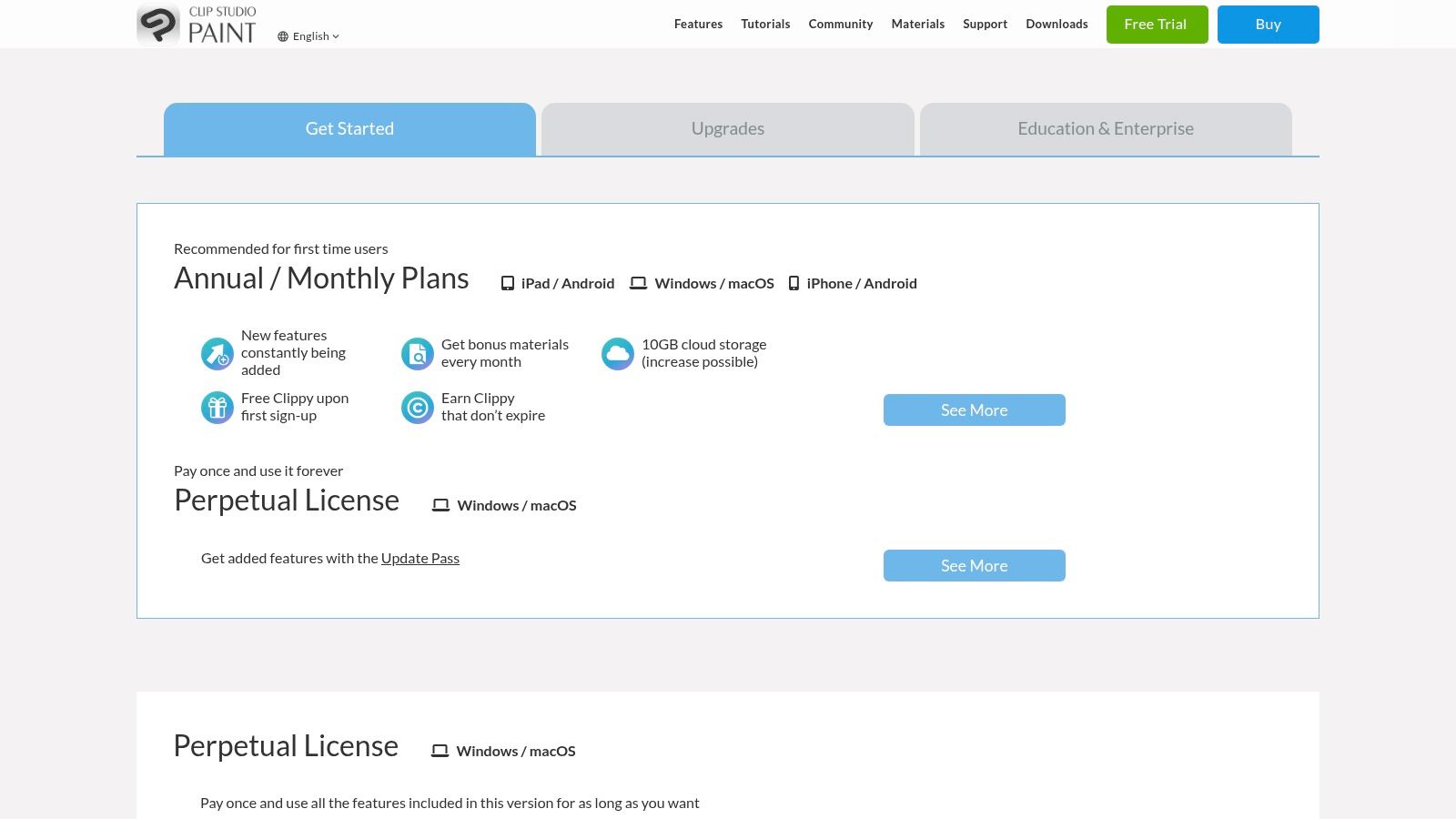
What sets Clip Studio Paint apart is its world-class drawing engine. The brush customization is second to none, giving your animations a natural, hand-drawn feel that other vector-based software can't easily replicate. This focus on the drawing experience makes it ideal for creating short animated loops, expressive GIFs, and character-driven shorts where the quality of the linework is paramount.
Clip Studio Paint integrates animation into a familiar digital art workspace, making the transition seamless for artists.
Integrated Animation Timeline: The timeline is straightforward, featuring essential tools like onion skinning to see previous and next frames, light table functions, and easy frame management. It feels like an extension of the drawing canvas, not a separate, complex module. Exceptional Drawing Tools: Leverage thousands of customizable brushes and vector tools to create your animation. The pen pressure sensitivity and stabilization features are top-tier, ensuring every line is just how you want it. Vast Asset Library: Access a massive library of user-created brushes, 3D models, and materials through the Clip Studio ASSETS store. This can dramatically speed up your workflow, especially when creating backgrounds or using poseable character models as references.
Clip Studio Paint offers incredible flexibility in how you purchase it. You can opt for a low-cost monthly subscription or buy a one-time perpetual license for the PRO or EX version. It's available on nearly every device, including Windows, macOS, iPad, Android, and Chromebooks, making it one of the most accessible options available.
Our Take: Clip Studio Paint is the ideal choice for illustrators who want to start animating. Its artist-first approach prioritizes the drawing experience, which is often the biggest hurdle for newcomers. The PRO version has a 24-frame limit, which is perfect for GIFs and short loops, while the EX version unlocks unlimited frames for more ambitious projects. The powerful drawing tools even rival what's possible with modern AI; you can explore the differences when you check out the best AI image generators.
If you find the idea of drawing every single frame of animation intimidating, Reallusion's Cartoon Animator 5 might be the perfect entry point for you. This platform excels at character puppeteering, allowing you to bring 2D characters to life using rigged templates and motion capture instead of traditional frame-by-frame drawing. It’s one of the best animation software for beginners who want to create expressive character animations quickly and efficiently, focusing more on performance than on illustration.
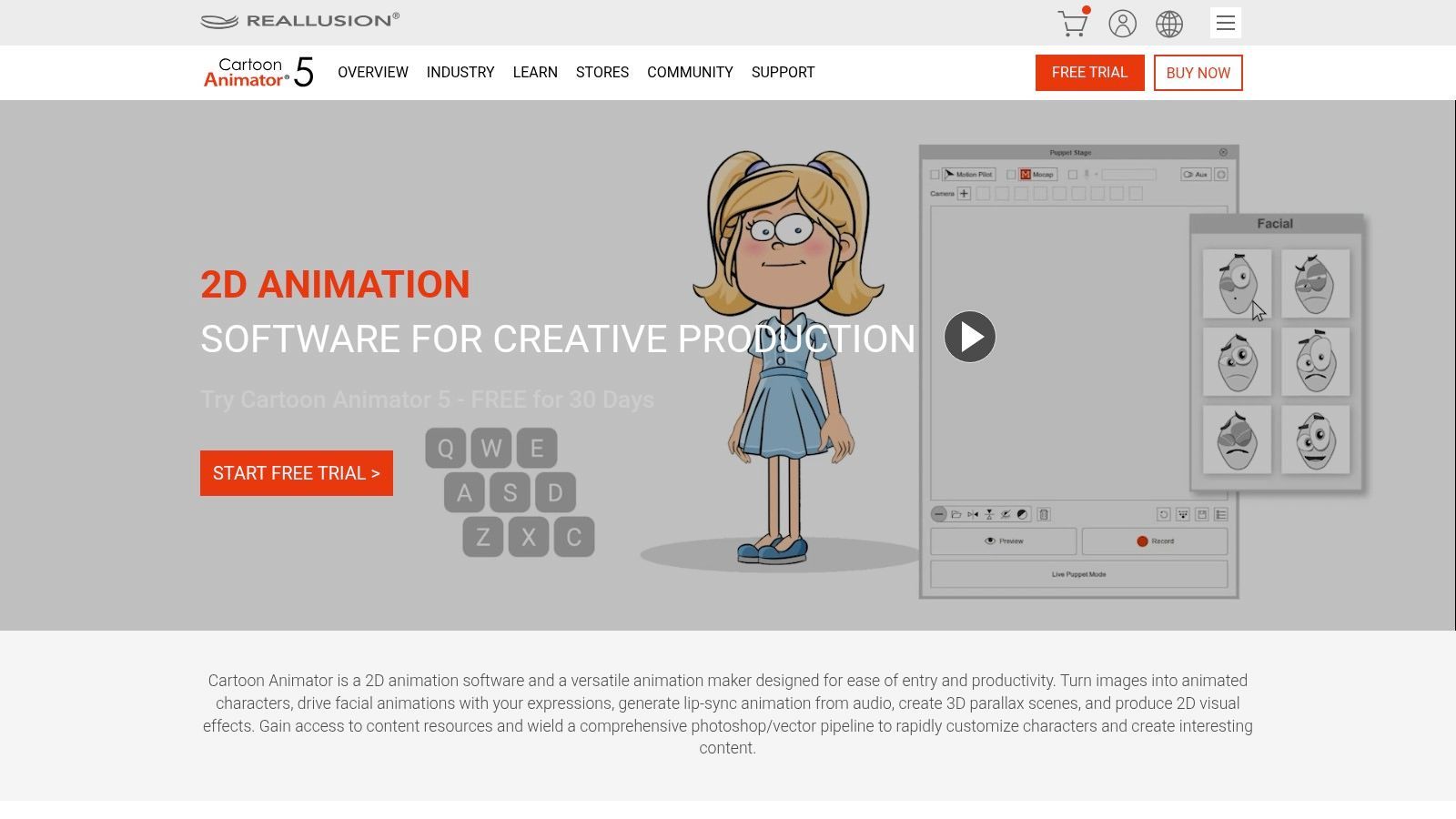
What truly sets Cartoon Animator apart is its emphasis on accessibility and powerful, real-time animation tools. You can literally bring a character to life using your own facial expressions through a webcam. This focus on mocap technology makes the animation process feel more like directing a performance, which is a fun and intuitive way for newcomers to get started.
Cartoon Animator 5 is designed to get you animating fast, with a suite of features that simplify complex character movements.
Real-Time Facial Mocap: Using just your webcam, you can capture your facial expressions and apply them to your 2D characters in real-time. This feature is incredibly engaging and makes dialogue scenes a breeze to animate. Vector and PSD Pipeline: You can import characters from programs like Adobe Photoshop or Illustrator, and Cartoon Animator will automatically rig them for you. The Free Form Deformation (FFD) and Spring Dynamics tools let you add lively, secondary motions to accessories and hair with just a few clicks. Extensive Content Marketplace: Reallusion offers a huge marketplace full of pre-made characters, motions, and props. This allows you to build a library of assets and focus purely on storytelling and animation.
Unlike the subscription-heavy industry, Cartoon Animator 5 uses a perpetual license model. You buy the software once and own it forever. There are different editions available, so you can choose the one that fits your budget and needs. While the core software is a one-time purchase, be aware that advanced mocap plugins and many content packs are sold separately.
Our Take: Cartoon Animator 5 is a fantastic choice for aspiring YouTubers, content creators, and storytellers who want to produce character-driven content without a steep learning curve. The puppeteering and mocap features are a game-changer for beginners. The main drawback is its Windows-only limitation, but for PC users, it’s a powerful and cost-effective tool. To explore similar character creation tools, see how you can transform your face to cartoon with modern technology.
While you might know Steam as the world's largest digital storefront for PC games, it has quietly become a fantastic hub for creative software, including a dedicated section for animation and modeling. This makes it an unexpectedly great starting point and one of the best animation software for beginners because it aggregates powerful tools into a familiar, user-friendly platform. It's not a single piece of software, but rather a curated marketplace where you can find, purchase, and manage tools like Blender, Krita, and Cascadeur with ease.
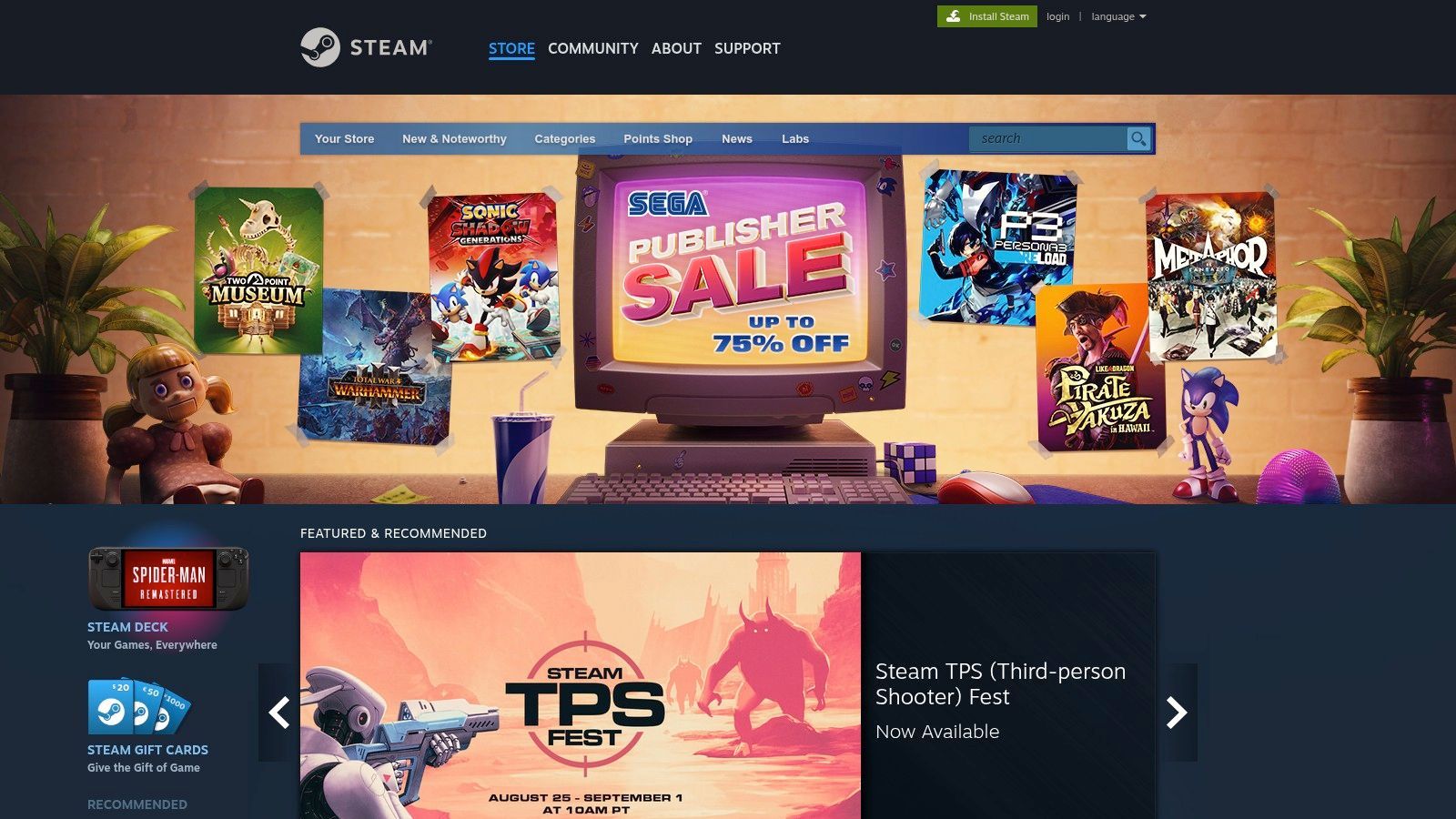
What makes Steam so powerful for a newcomer is its built-in ecosystem. Forget hunting down installers on different websites; Steam handles installation, automatic updates, and even cloud saves for your project files. More importantly, the user reviews and community hubs provide invaluable, real-world feedback from other creators, helping you decide which program is the right fit before you spend a dime or an hour of your time.
Steam simplifies the often-intimidating process of getting started with creative software by wrapping it in a convenient, all-in-one package.
Centralized Software Library: Access a diverse range of animation tools, from free, open-source powerhouses like Blender and Krita to paid, specialized software, all in one place. Automatic Updates & Easy Installation: Steam manages the installation and updates for you. When a new version of your chosen software is released, Steam downloads and applies it automatically, ensuring you always have the latest features and bug fixes. Community Reviews and Guides: Leverage the massive Steam community. User reviews offer honest pros and cons, while the community hub for each app often contains user-made tutorials, guides, and discussions that are incredibly helpful for beginners.
The beauty of the Steam - Animation & Modeling Software Category is its variety in pricing. You can find completely free, professional-grade software like Blender alongside paid applications that often go on sale during Steam's famous seasonal events. This flexibility allows you to start with free tools and invest in paid ones as your skills and needs grow, all within the same platform.
Our Take: For beginners who feel overwhelmed by the sheer number of animation tools available, Steam is the perfect gateway. It lowers the barrier to entry by simplifying software management and providing a community safety net. Being able to read reviews, watch workshop videos, and get everything installed with one click makes the initial learning curve far less daunting.
| Software | Implementation Complexity 🔄 | Resource Requirements ⚡ | Expected Outcomes 📊 | Ideal Use Cases 💡 | Key Advantages ⭐ |
|---|---|---|---|---|---|
| Adobe Animate | Moderate – beginner-friendly tools | Moderate – heavier install, Adobe CC subscription | Polished 2D animations and interactive web content | Beginners learning web/social media animation | Strong tutorials, broad export formats, industry standard |
| Toon Boom Harmony | High – steep learning curve | High – professional-grade features, costly pricing | Studio-quality rigged & traditional animations | Scaling from beginner to professional use | Scalable tiers, rich features, strong educational support |
| Moho (Lost Marble) | Low to moderate – bone rigging focus | Low – one-time purchase, lightweight | Smooth rigged animations with physics | Beginners wanting affordable rigging tools | One-time buy, clear upgrade path, physics & smart meshes |
| Blender | High – complex interface | Moderate to high – 3D capable, GPU dependent | Both 2D and 3D animations, compositing | Experimentation in 2D/3D without cost | Free and open-source, large community, versatile pipeline |
| Clip Studio Paint | Low – simple timeline features | Low to moderate – multiple platforms | Short loops, GIFs, hybrid illustration/animation | Illustrators transitioning to animation | Excellent drawing tools, affordable, strong community |
| Cartoon Animator 5 | Low to moderate – rigging & mocap focused | Moderate – Windows-only, add-ons may add cost | Rigged character animation with mocap | Character puppeteering, beginners preferring rigging | Perpetual license, mocap features, extensive add-ons |
| Steam - Animation & Modeling | Very low – platform for apps | Variable – depends on chosen software | Easy access and installation of tools | Beginners needing easy install & updates | One-click installs, community reviews, access to various apps |
And that’s a wrap! You've just explored a fantastic lineup of contenders for the best animation software for beginners. We've journeyed through everything from the industry-standard powerhouses like Adobe Animate and Toon Boom Harmony to the incredibly versatile and free open-source giant, Blender. The path to your first animated masterpiece is clearer than ever.
The key takeaway? There's no single "perfect" choice, only the perfect choice for you. Your ideal software hinges entirely on your goals, your budget, and the style you want to create. Don't get stuck in "analysis paralysis" by trying to find the one tool that does it all. Instead, focus on the one that gets you creating now.
Feeling a little overwhelmed by the options? Let's break it down into actionable steps to help you choose your creative partner.
For the Aspiring Pro: If you have dreams of working in a professional studio or creating broadcast-quality cartoons, investing your time in Toon Boom Harmony or Adobe Animate is a smart move. Their workflows are what the pros use, giving you a valuable head start. For the All-in-One Creator: If you want a single program that can handle 2D, 3D, video editing, and visual effects without costing a dime, Blender is your undisputed champion. The learning curve is steep, but the payoff is an unparalleled level of creative freedom. For the Character Animator: If bringing characters to life with intuitive rigging and bone systems is your main goal, look no further than Moho Debut or Cartoon Animator 5. These tools are specifically designed to make character animation faster and more accessible. For the Illustrator Turned Animator: If you already love to draw and live in a program like Photoshop, Clip Studio Paint offers a seamless and familiar transition into the world of frame-by-frame animation.
Choosing the software is just the first frame of your animation journey. The real progress happens when you roll up your sleeves and dive in. Don't just download the program and let it sit on your desktop.
Commit to taking that next step. Find a "getting started" tutorial on YouTube for the software you chose and follow along. Your first project doesn't need to be a magnum opus; make a simple ball bounce, animate a blinking eye, or create a wiggling line. The goal is to build momentum.
Remember, every great animator started exactly where you are now: with an idea and the courage to press "new project". The software is simply the paintbrush; your imagination, practice, and persistence are what will bring your stories to life. Your animation adventure has officially begun!
Ready to add a revolutionary AI-powered edge to your animations? SendFame can elevate your projects by generating stunning, dynamic video clips from static character art or even composing custom theme music for your animated shorts in seconds. Supercharge your creative workflow and bring your ideas to life faster than ever at SendFame.
Create Epic
SendFame